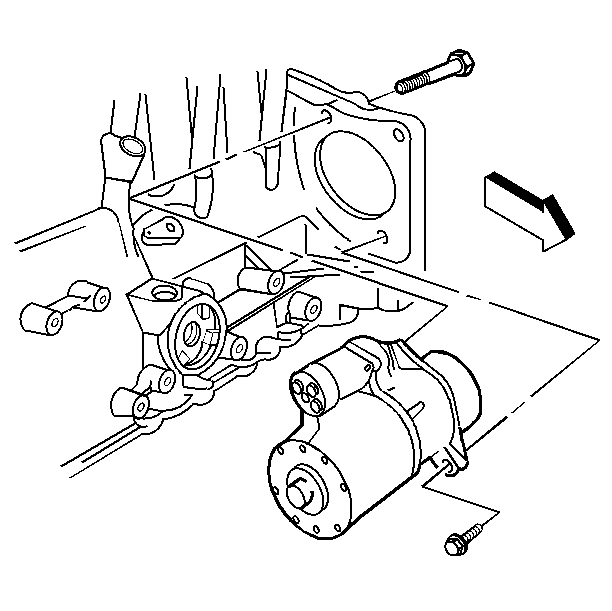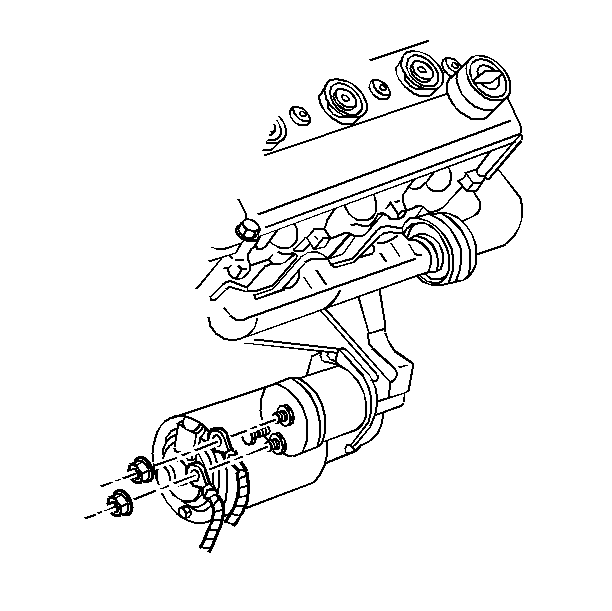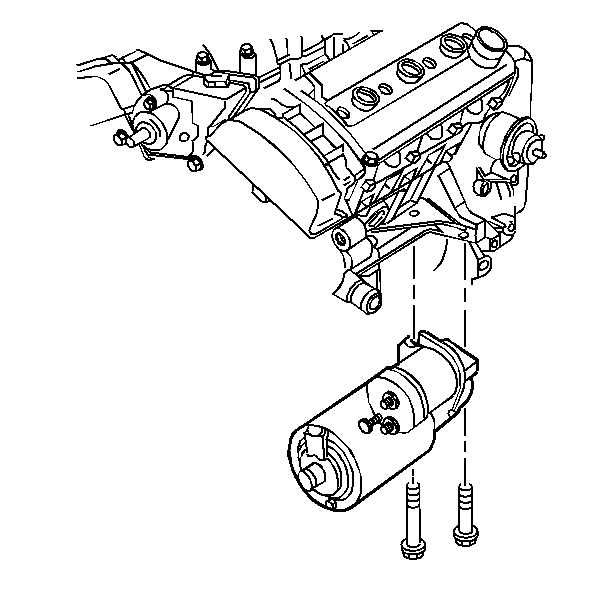Starter Replacement 2.4L
Removal Procedure
- Disconnect the negative battery cable.
- Disconnect the air inlet duct to the throttle body.
- Remove the top starter bolt.
- Raise the vehicle. Refer to Lifting and Jacking the Vehicle in General Information.
- Remove the lower closeout panel.
- Remove the lower starter bolt.
- Position the engine wiring harness aside.
- Position the starter for access to the solenoid wiring.
- Remove the electrical wiring.
- Remove the starter.

Caution: Unless directed otherwise, the ignition and start switch must be in the OFF or LOCK position, and all electrical loads must be OFF before servicing any electrical component. Disconnect the negative battery cable to prevent an electrical spark should a tool or equipment come in contact with an exposed electrical terminal. Failure to follow these precautions may result in personal injury and/or damage to the vehicle or its components.
Installation Procedure
- Install the electrical wiring.
- Position the starter to the engine.
- Install the lower starter bolt.
- Reposition the engine wiring harness.
- Install the lower closeout panel.
- Lower the vehicle.
- Install the top starter bolt.
- Connect the air inlet duct to the throttle body.
- Connect the negative battery cable.

Notice: Use the correct fastener in the correct location. Replacement fasteners must be the correct part number for that application. Fasteners requiring replacement or fasteners requiring the use of thread locking compound or sealant are identified in the service procedure. Do not use paints, lubricants, or corrosion inhibitors on fasteners or fastener joint surfaces unless specified. These coatings affect fastener torque and joint clamping force and may damage the fastener. Use the correct tightening sequence and specifications when installing fasteners in order to avoid damage to parts and systems.
Tighten
Tighten the cable to the solenoid 12 N·m (106 lb in)
Tighten
Tighten the bolt to 90 N·m (66 lb ft)
Tighten
Tighten the bolt to 90 N·m (66 lb ft)
Tighten
Tighten the bolt to 16 N·m (12 lb ft)
Starter Replacement 3.4L
Removal Procedure
Important: The 3.4L engine uses the PG260M starter motor. This starter motor is serviced as a unit.
- Disconnect the negative battery cable.
- Remove the flywheel inspection cover bolts.
- Remove the flywheel inspection cover.
- Remove the electrical connections from the starter motor.
- Remove the starter motor mounting bolts.
- Remove the starter motor.
Caution: Unless directed otherwise, the ignition and start switch must be in the OFF or LOCK position, and all electrical loads must be OFF before servicing any electrical component. Disconnect the negative battery cable to prevent an electrical spark should a tool or equipment come in contact with an exposed electrical terminal. Failure to follow these precautions may result in personal injury and/or damage to the vehicle or its components.


Installation Procedure
- Secure the electrical terminal on the solenoid.
- Install the electrical connections to the starter motor.
- Install the starter motor to the engine.
- Install the starter motor mounting bolts.
- Install the flywheel inspection cover.
- Install the flywheel inspection cover bolts.
- Connect the negative battery cable.
Notice: Before installing the starter motor to the engine, tighten the nut next to the cap on the solenoid BAT terminal. If this terminal is not tight in the solenoid cap, the cap may be damaged during installation of electrical connections and cause the starter motor to fail later.

Notice: Use the correct fastener in the correct location. Replacement fasteners must be the correct part number for that application. Fasteners requiring replacement or fasteners requiring the use of thread locking compound or sealant are identified in the service procedure. Do not use paints, lubricants, or corrosion inhibitors on fasteners or fastener joint surfaces unless specified. These coatings affect fastener torque and joint clamping force and may damage the fastener. Use the correct tightening sequence and specifications when installing fasteners in order to avoid damage to parts and systems.
Tighten
Tighten the solenoid battery terminal inside nut to 9.5 N·m
(84 lb in).
Tighten
| • | Tighten the solenoid battery terminal outside the nut to 9.5 N·m (84 lb in). |
| • | Tighten solenoid S terminal outside the nut to 2.5 N·m (22 lb in). |

Tighten
Tighten the starter motor mounting bolts to 43 N·m (32 lb ft).
Tighten
Tighten the bolts to 10 N·m (89 lb in).
Tighten
Tighten the cable bolt to 15 N·m (11 lb ft).
